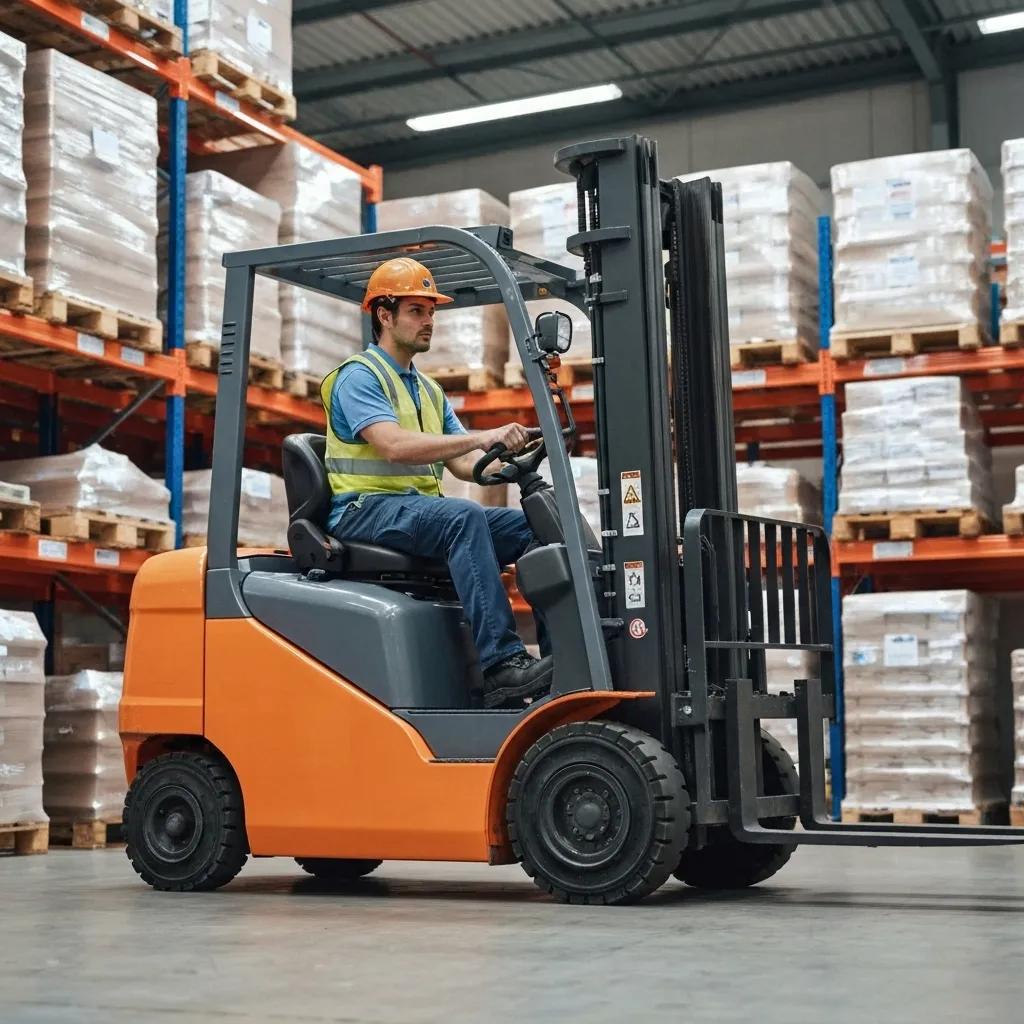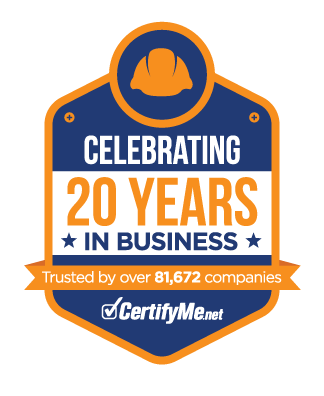Forklift Safety Training vs. OSHA Forklift Certification: Key Differences Explained
Posted by: admin on August 29, 2025

What Is the Difference Between General Forklift Safety Training and OSHA Compliant Forklift Certification?
Forklift incidents injure thousands of workers each year. That’s why it’s important to know the difference between general forklift safety training and OSHA-compliant forklift certification.
- General training builds basic awareness: how a truck works and common hazards.
- OSHA-compliant certification (under 29 CFR 1910.178) requires formal instruction, hands-on practice, and a performance evaluation. The employer must document it for the specific truck type and worksite.
This guide explains the scope of general training, OSHA’s requirements, documentation differences, and how to choose training formats.
What Does General Forklift Safety Training Include?
General forklift safety training gives new operators the essentials: controls, basic load handling, and common risks. Think of it as a primer before the OSHA process.
What Are the Key Components of Basic Forklift Safety Training?
General courses usually cover three basics:
- Equipment Orientation – Truck types, controls, rated capacity, center of gravity, and the stability triangle.
- Operational Skills – Safe steering, lifting, lowering, traveling, braking, and maneuvering.
- Pre-Shift Inspections – Visual checks for leaks, loose parts, tire condition, forks and chains, and load security.
These topics build confidence but do not replace OSHA’s required evaluation.
How Does General Training Address Workplace Hazards?
General training raises awareness of site hazards, such as:
- Slippery floors, potholes, and uneven surfaces
- Low beams, racking, and poor lighting
- Bad stacking, unbalanced pallets, and tall loads that block view
This hazard recognition helps operators avoid basic mistakes and prepares them for OSHA’s formal testing.
What Are the Limitations of General Forklift Safety Training?
General training alone has gaps:
- No enforceable performance test
- No standardized documentation tied to a specific truck and site
- No required recertification
Without the OSHA-required hands-on evaluation and employer records, a company remains exposed to compliance citations and higher injury risk.
What Are the OSHA Requirements for Forklift Certification?
OSHA-compliant certification proves that forklift operators can safely and correctly use equipment. It’s required under federal law and helps reduce accidents and liability for employers.
What Is OSHA Standard 29 CFR 1910.178 and Its Role?
OSHA Standard 29 CFR 1910.178 is the rule that covers powered industrial trucks, including forklifts. It regulates how they are designed, maintained, and operated. Most importantly, it requires employers to train and certify every forklift operator. This shifts the legal responsibility to the employer to make sure workers are properly trained and documented.
OSHA Standard 29 CFR 1910.178: A Summary
This rule requires:
-
Safe truck design and regular maintenance
-
Mandatory operator training on safe use and hazards
-
Employer responsibility for providing and documenting certification
The purpose is to reduce forklift accidents and keep workplaces safe.
What Are the Three Parts of OSHA Compliant Forklift Certification?
OSHA certification has three main steps:
-
Formal Instruction – Classroom or online learning that covers rules, safety practices, and forklift basics.
-
Practical Training – Hands-on operation, including steering, stacking, handling loads, and emergency skills.
-
Performance Evaluation – A qualified trainer watches and evaluates the operator to confirm safe use.
This three-step process ensures that what workers learn in theory is applied safely on the job.
What Are Employer Responsibilities Under OSHA?
Employers must:
-
Provide site-specific training for the type of forklift and environment.
-
Use certified instructors and keep detailed training records.
-
Reevaluate operator performance at least every three years, or sooner if there’s a change in conditions.
Keeping these records creates a clear compliance trail in case of an OSHA audit.
How Often Is Refresher Training Required by OSHA?
OSHA requires refresher training every three years, or sooner if:
-
An operator has an accident or near miss.
-
Unsafe driving is observed.
-
The operator switches to a different forklift type.
-
Worksite conditions change.
Refresher training ensures operators stay sharp and safe as jobs and environments evolve.
How Do OSHA Compliant Certification and General Training Differ?
| Category
|
General Forklift
Safety Training |
OSHA-Compliant Forklift Certification
|
|---|---|---|
| Purpose
|
Basic awareness of forklift controls and hazards
|
Legally required proof of safe and competent operation
|
| Content
|
Equipment orientation, basic operation, hazard awareness
|
Formal instruction, hands-on training, and performance evaluation
|
| Trainer Requirement
|
May be taught by general staff or third-party
|
Must be taught and evaluated by a qualified trainer
|
| Documentation
|
Often no official records kept
|
Employer must maintain training and certification records
|
| Performance Standards
|
No enforceable test or benchmarks
|
Mandatory performance evaluation under OSHA 29 CFR 1910.178
|
| Recertification
|
Not required
|
Required every 3 years, or sooner after accidents, unsafe behavior, or changes in equipment/site
|
| Compliance Value
|
Provides general awareness but not OSHA-compliant
|
Meets federal standards, reduces liability, and passes OSHA audits
|
What Are the Legal Implications of OSHA Certification vs. General Training?
OSHA-compliant forklift certification shows that an employer has done their due diligence in training operators. This helps protect the company from fines, liability claims, and legal action if an incident occurs. By contrast, general training alone does not meet OSHA’s audit standards and cannot be used as a defense during an inspection or lawsuit.
How Do Training Outcomes and Operator Competency Vary?
Operators who complete OSHA certification demonstrate stronger skills than those with only general training. Certified operators are better at:
-
Controlling loads safely
-
Managing forklift stability
-
Responding quickly to hazards
This higher skill level reduces work stoppages, lowers accident rates, and improves overall productivity.
What Are the Differences in Employer Documentation and Record-Keeping?
OSHA requires employers to keep detailed training and certification records, including:
-
Training dates
-
Instructor qualifications
-
Performance evaluation results
General safety training, on the other hand, often leaves little or no paper trail. Without official documentation, employers are exposed during audits or inspections.
How Does Certification Impact Workplace Safety and Accident Prevention?
Businesses that use OSHA-aligned forklift certification programs report up to 70% fewer forklift accidents, according to the National Institute for Occupational Safety and Health (NIOSH, 2023). Certification lowers the number of injuries, reduces medical claims, and cuts costly downtime. Even more, it helps create a culture of safety that benefits both workers and employers.
Forklift Accidents and the Impact of Certification
Research shows that OSHA-aligned certification not only improves operator competence but also reduces accident frequency. Trained operators are better prepared to handle real-world challenges like uneven floors, heavy loads, and pedestrian traffic. Compared to general training, OSHA certification delivers a measurable impact on workplace safety and performance.
How Can Employers Choose Between Online and In-Person Forklift Training?
When selecting forklift training, employers must weigh cost, accessibility, and OSHA’s hands-on requirements. Both online and in-person formats can meet OSHA standards when used correctly.
What Are the Pros and Cons of Online Forklift Training?
Online forklift training works well for the classroom portion of OSHA’s three-part requirement.
Pros:
-
Flexible scheduling
-
Lower cost per operator
-
Easy access from any location
Cons:
-
Does not cover OSHA’s hands-on and evaluation steps by itself
-
Requires on-site practice and observation to complete certification
How Does In-Person Training Meet OSHA Requirements?
In-person training combines classroom and practical learning in the same setting. Benefits include:
-
Live demonstrations of forklift controls and safe operation
-
Immediate feedback and correction from the trainer
-
Direct evaluation of operator skills
This format fully aligns with OSHA’s formal instruction, practical training, and performance evaluation requirements.
Can Online Training Fulfill OSHA’s Practical Training Mandate?
Yes—online programs can meet OSHA rules when paired with on-site practice and evaluation. A blended model works like this:
-
Complete the classroom portion online
-
Perform supervised hands-on training at the job site
-
Pass a performance evaluation by a qualified instructor
This ensures the certification covers both knowledge and practical skills.
Forklift operators who complete OSHA-compliant certification—whether online, in-person, or blended—gain more than legal compliance. They also show higher skill levels, lower accident rates, and help build a lasting culture of workplace safety.
Welcome to CertifyMe.net
CertifyMe.net has offered online forklift certification since 1999. With Our Convenient online program. your employess can earn their certification in an hour or less.
Browse Online Certifications:
This low-cost program can be compeleted anytime, anywhere!





